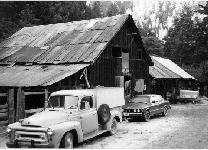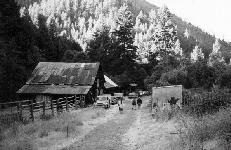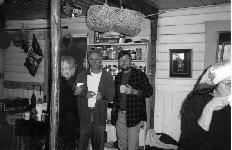Black Bear Solstice Reunion 1987
By Don Monkerud
Greyish blue folds of mountains recede into the distance, one
atop the next, like waves in the ocean, wisps of light fog still
clinging to the early morning peaks. The slopes are covered with
evergreen forest and distant slashes of dirt mark roads which
wind their way between the bare earth of clearcut logging blocks,
along river highways and cut knife-like up jagged mountain
ridges.
At a lookout point on a ridge, the mountains make me feel on
top of the world; a world that stretches below me and offers a
maze of peaks and ridges requiring a map to sort out the jig-saw
puzzle of wilderness names like Grasshopper Ridge, Haypress
Meadows, Chimney Rock and Bear Valley.
My journey into the depths of the mountains has just begun.
I'm returning to a place where, almost 20 years ago, a collection
of hippies, draft dodgers, old beatniks, anarchist, drop outs and
space cadets moved into a mountain commune. They sought to escape
the Haight Ashbury in San Francisco, the draft and the Vietnam
War, overbearing parents and a culture many of them considered
corrupt and hypocritical. Over fifty adults and children
collected money from welfare checks, inheritances, savings, and
extortion from rock bands to buy 80 acres surrounded by national
forest, four hours away from electricity and the nearest
hospital. The locals claimed they wouldn't last the winter and,
if it hadn't been for dope runs to San Francisco, hikes through
the snow to replenish the tobacco supply and their dedication to
creating what they called "a new culture," they
wouldn't have lasted.
But they did survive the winters at what is called "the
Ranch." Although many have returned to the city or moved
nearby to integrate with the local towns, the place continues to
survive. On solstice over two hundred people will celebrate the
creation of a land trust which will pass the ownership from an
individual to legal collective ownership. The land will be
protected from lawsuits, the children who grew up there will be
added as owners and, hopefully, the Ranch will continue to
provide space for people living outside the mainstream of
corporate America.
A one lane twisting road hugs the granite cliffs on one side, the
other drops off to a boulder strewn river. The firs and pines
wave at me like children playing across the mountain ridges and,
when they hear the car, deer slow, perk their ears and plunge off
the embankment.
On the way into the Ranch I pass the richest hard rock mine
in Northern California which gave Black Bear its name when
established in l860. By l869 over 300 miners -- some with
families -- lived and worked here but now, only sounds of the
creek greet me as I park among the trees and walk down to the
mainhouse. Hidden behind apple trees and surrounded by a six foot
high wooden fence, the mainhouse yard is filled with tall green
grass, barking dogs and children playing hide-and-seek. A lone
hawk catches an updraft and hangs motionless above the old
schoolhouse down by the junkyard.
Directly across the dusty road looms the barn, its post and
beam framework held together by pegs and the weathered siding
fastened with handmade iron nails. A vast patchwork of salvaged
tin covers the roof and one skeleton-like corner hangs,
unsupported, above a crumbling rock foundation. A light shines
from the doorway and goats bleat while being milked. In the barn
loft the first baby boy, Shem, was born 19 years ago. Thirty
people packed into the loft, smoking dope, stoking the woodstove,
laughing, and singing songs during the birth. Some twenty babies
were born here and all but one, three months premature, lived.
Many of those kids will return and I'm anxious to meet them
again.
Sounds of drums echo across the valley and, inside the house,
electric lights illuminate the room. Today, a pelton wheel runs
an alternator to produce 12 volt electricity, a vast improvement
over the kerosene lamps we formerly used. The original floorplan
had many small bedrooms where rumors claim the owner of the
goldmine, John Daggett, virtually imprisoned his daughters when
he rode off to Sacramento on state business while he was Lt.
Governor of California. Now one spacious room, the roof supported
by a madrone trunk, contains several dozen people.
In the front room, a figure in a black hat plays the piano
and small knots of people laugh and talk, renewing old
friendships and greeting people they haven't seen in years. A
table filled with food sits to one side holding a heaping basket
of whole wheat bread sticks, a ten gallon bowl of salad and
army-sized trays of apricot cobbler. In the back room, along one
wall of the kitchen, stainless steel sinks are kept busy with
people washing dishes, brushing their teeth or filling tea
kettles. Like when I lived here, several 5 gallon buckets of
garbage just below the sink are overflowing.
Tom, who lives in Seattle, greets me with a hug, pushes his
glasses back and talks of the trips he has made to Nicaragua to
improve the utilities. "We've cut the average blackouts in
the electrical system from six hours a day down to two," he
says, placing his arm around his girlfriend and taking a swig of
beer. "But you heard about the American being killed down
there? We worked with him. I've reevaluating whether I'm going to
continue working there. I've been doing this so many years."
Tom turns to another acquaintance and I greet Brian, who has
come from Fort Worth, Texas. His upper body is husky although he
admits to growing pain from transporting his polio crippled legs
on crutches. He pushes a Greek sailor's hat back on his head and
smiles as he explains his research to build exact scale models of
Civil War battleships on the Mississippi.
The mainhouse was always a place where the most intimate and
deep conversation occurred instantaneously. In the old days, I often
went from one intense discussion to the next, each lasting
minutes or hours. The subjects ranged from self-doubts to
jealousy, from falling in love to the collective issue of the
moment: the kids' collective; a food run to the city; the women's
house; or whether to kill a goat for dinner. During periods when
we worked on collective projects like digging new irrigation
ditches or terracing new gardens, we missed "getting in
touch with our feelings;" when we concentrated on our
feelings, we complained about lacking collective energy to begin
new work projects. The precarious balance between what some
called the emotional sink of feeling and our workaholic heritage
see-sawed with the seasons, the amount of food in the larder and
some claimed, the phases of the moon. Tonight some of the same
intensity remains but we have matured; by 11 P.M. the house is
almost deserted.
At breakfast the next morning, 30 coffee addicts crowd around the
10 foot long cookstove, carefully watching coffee drip into pots
and performing individualized coffee rituals. In the past people
smoked dope but it's clear this morning; the main drug abuse
today is coffee. Even the teenage boys, are loading the espresso machines and the dark, thick aroma of coffee permeates the air.
On the table in the living room, homemade granola, yogurt,
bananas, oranges, whole wheat bread and oatmeal fill the table.
Everyone drinks cup after cup of coffee, the supply never
adequate to keep up with demand.
New arrivals sign in at a table in front of the mainhouse and
transfer interests in the Ranch to the Black Bear Family Trust.
Fifty "settlors," who had a collective obligation for
the purchase and maintenance of the land, are signing over their
ownership rights to the trust. According to the legal document,
the trust will perpetuate the forest community to preserve the
water, soil, wildlife and forest resources in ecological balance.
A list of "beneficiaries" may visit or reside at the
Ranch according to rules established by the collective. A board
of trustees, consisting of six past and present residents, will
manage the property and the beneficiaries will vote on important
issues. Votes to change the rules can be called by ten percent
petition of the beneficiaries. The trust will last for 60 years.
The Ranch has always been a loose affiliation, more or less
sharing a common outlook and purpose, but never following a
leader or a particular creed. We used to joke that at any given
time you could ask people why they lived here and you would get
as many answers as people, most of them having to do with living
collectively in the wilderness, being self-sufficient and
rejecting the "rat race." Now only a dozen residents
remain, living much the same way we did back then.
After meeting to plan ceremonies for Saturday night and
Sunday morning to formally transfer the land, I volunteer with
Doug, who runs his own forestry outfit out of Eugene, Oregon,
and Gail, who is now a CPA, to build a portal for the evening's
procession to pass through. Doug and I walk up the road to find
Gail and Peter, who runs a custom cabinet making shop in San
Francisco, cutting alder poles in the creek. We carry the poles
up the road, use bailing wire and nails to erect tripods and hang
the jawbone of an ass, deer antlers and a bundle of mullen from
the cross piece. Peter grabs a ladder to climb the precariously
balanced tripod and the three of us yell that he'll break his
neck. He ignores us and magically drives nails without toppling
the whole structure.
"Things are just like they always were," he
comments after climbing down. "Everybody tells you what to
do and you just have to ignore them and do what it takes to get
the job done."
We return to the mainhouse to a lunch of three kinds of
cheeses, cases of avocados, mounds of whole wheat bread, huge
bowls of potato salad and a 25 gallon crock of marinated bean
salad. The food anxieties we experienced when we lived here are
gone; then you feared that if you missed a meal no one would save
you any food and there wouldn't be enough to go around. Food runs
were vital links between the city and the Ranch and had to be
made regularly to replenish 55 gallon barrels of oil, 60 pound
tins of honey and 100 pound sacks of wheat, rice, beans and
powdered milk. Now there's more than enough food for everyone.
After lunch I talk to some of the kids who were born here and are
now young adults who are the same ages we were when we first came
to the Ranch. Laura is a junior in political science at UC Santa
Barbara and will intern for a congressman in Washington this
summer. Yoni has a new baby and manages a boutique in Yreka. Shem
is working part-time in a health spa and attending S.F. State
studying philosophy. Many of the kids still visit the Ranch every
summer, continue their friendships and several of them arrived
early to organize the weekend festivities.
The kids are different than we were: we rejected material
success, they embrace it; we rejected our parents and their
values, they accept us. We isolated ourselves in the woods; they
are able to freely move back and forth. Although we didn't create
an isolated culture, separate from the rest of society like the
Amish, we did isolate the children in the wilderness during their
formative years. Yet today, they have open and accepting
attitudes, cosmopolitan outlooks and close communal bonds. We
always claimed the future belonged to our children and now we see
the truth of that statement.
We walk to the meadow where small children splash in the
shallow end of the pond and a sweat lodge releases a thin column
of wood smoke. On ceremonial occasions in the past, like solstice
and equinox, 40 to 80 of us took steam baths in a plastic covered
pole dome next to the creek. Now a new Indian-style sweat lodge
has been constructed; a trench was dug into the ground, a barrel
stove placed in one end and the top covered with earth.
Crawling through the narrow opening, I immediately feel
claustrophobic and break out in a profuse sweat. Darkness erases
all reference points and the hot air stings my lungs. Allegra, a
4 year old Black Bear native, makes up melodious songs which she
calls angel's songs and several women sing peaceful and
comforting chants.
Incense cedar boughs are placed on the floor for their scent.
We rub cornmeal over each other and this becomes a religious
experience; the heat, the chanting, the sweating and the darkness
conspire to strip all visual stimulation; the darkness becomes a
world of spirits. Slowly I feel cleansed as the city food, air
and stress rolls off me in sweat to drip into the earth.
Star sits next to me in the darkness and says a man's
presence is unusual for she lives in a women's world; her social
activities are with women; her friends are women; she has nothing
to do with men. "People used to be threatened by us, but
that antagonism is gone now. I guess we've made some progress in
the past 15 years."
Star explains that women had held "healing sweats"
for years; women gather to heal each other by singing songs,
talking in groups and meditating on those who are ill or need
strength. Earlier in the day, the women gathered on the knoll and
everyone spoke: remembering people who weren't there; stating the
significance of the solstice and the trust; accepting the death
of Meredith, who is dying of bone cancer in San Francisco;
recalling past events; and projecting a fulfilling future. She
says the women have a collective strength and support each
other's personal development.
Before the women asserted themselves, the Ranch, copying the
larger society, was male-dominated. By holding women's meetings,
forming a women's house and taking leadership roles, Ranch women
established their independence. At first, they worked on trucks,
handled rifles and wielded chainsaws. People sought their own
level of activity based upon preference and ability, not sex. The
results can be seen today at the Ranch. Men are cooking and
caring for the children, women hold full-time jobs and, while
conflict remains, the old stereotypes are gone.
At 11 o'clock that night, we began the solstice ceremony by
following a heavy wooden totem and dozens of candles in cans
called "Salmon River bugs." Strung out on the road like
fireflies, the soft haloes of light bounced across the road and
into the dark forest. We walked beneath a cold, clear sky, the
forest towering above us, an owl hooting in the distance. At
selected intervals we stopped, bindles or hobo bundles were
unrolled and various objects were revealed to tell stories from
Black Bear's history.
Efrem and Jeff's bundle held a plastic bag of herbs,
resembling marijuana, to recount the first spring when the
Siskiyou County sheriff busted the Ranch for dope. Jeff told of
awakening one morning l9 years ago when John tossed a joint out
the window directly in front of a sheriff's deputy. After days in
jail, Jeff appeared in court handcuffed to thirty other hippies
busted around the county and was released due to insufficient
evidence. The sheriff posed for the local newspaper holding
evidence from the raid, a tomato plant.
Further down the road we stopped at a meadow which we had
terraced by painstakingly shoveling top soil into a pile,
leveling the subsoil and redepositing the topsoil into a bed like
we read they did in the revolutionary village of Lou Ling in
China. Osha rolled on the ground, clutching his stomach and
groaning. Michael ran to him, promised to cure him with herbs and
stuffed grass into his mouth. Osha continued to wither on the
ground until Owlin, a medical doctor, gave him penicillin. Owlin
claimed Michael was a quack and Michael pronounced Owlin a
technician without feelings. But then Owlin became sick and
Michael fed him herbs. Such is the stuff of legends.
On the knoll we gathered before a huge crackling bonfire,
much differently than we would have 20 years ago. Then we gorged
ourselves on roasted goat, drank homemade wine, smoked dope and
ran off with someone else's mate. Tonight such behavior would
precipitate a crisis. We listen to a '60's poem by Mary praising
the wonder of free sex which, with the threat of aids, may be
gone forever. Several songs were sung and poems recited, setting
the stage for the following day. By 10 A.M. the next morning,
everyone had gathered around a new bonfire on the knoll and
children carried boughs of burning incense cedar around the
circle to let the smoke waft over each person in a purification
ritual. Geba blew a greeting to the six directions with a small
reed flute and read an Indian poem reminding us that we cannot
own the land; the owls, the coyotes and the wild things own the
land. Statements of purpose from the trust were read. Efrem read
a manifesto from the first winter at the Ranch; the "Get
With It Party" rejected society's rules and promised to
create a "new culture." Michael talked about sacred
herbs, sprinkled some into the fire and we formed a circle and
clasped hands.
When we returned to the fire the six new trustees sat on a
log next to the fire and people in the circle rose to give
counsel on preserving the Ranch. Jeff wanted to preserve the
ecology and sacredness of this special place, Sala wanted to use
the Ranch for healing seminars and several voiced a desire to
provide a place for Central American refugees. The historic sites
should be preserved and the trees should never be clearcut.
Leslie rose to claim the 60's should not be forgotten and the
spirit which originally brought us here should be continued. If
we were serious about ecology and preservation, Carol said,
restrict the goats which have destroyed the native vegetation.
Clarence claimed if the goats were gone, all the vegetation would
return in a year. Deed suggested the real specialness of this
place was not the physical land but the people, the current and
past friendships and our collective energy which should be
maintained when we returned to the city. Again we rose to hold
hands in a huge circle.
Richard, in whose name the land was registered for l9 years,
paced the fire circle . "So the truth is out, some of you
knew and some of you didn't," he said. "I never owned
the land, I only held it in my name for all of you." He read
a poem Lew Welch wrote when he lived on the Salmon River in l962,
entitled "He prepares to take leave of his hut,"
concluding with the lines,
"Why should it be so hard to give up seeking something
you know you can't possess? Who ever said it was easy?"
The documents have been signed and the Black Bear Family
Trust is now officially the owner of the Ranch. In conclusion,
each person had collected some token which represented the Ranch
and we circled the fire dropping herbs, pine cones, special
rocks, sticks from the old Salmon smoker, and walnuts from the
tree at the mainhouse backdoor into a large bowl. Carol deposited
a huge iron screw, Missy a goat turd and Martine an old bent
clock face. After lunch, most people would be leaving for their
homes and work the next day.
So what has changed in twenty years? Most of us have turned
grey, gotten heavier around the middle, given up drugs and
settled down. Some live nearby; their hair remains long, they
live in the country and eke out a living working in the woods and
growing vegetables. They are involved in struggles against the
CIA's Contras, clear cutting and herbicide spraying. Others have
moved away and now work as nurses, scientists, businessmen,
building contractors, teachers, midwives and lawyers. The
majority continue to hold egalitarian, anti-war and ecological
political attitudes, deal with others in a real and humane way
and continue Ranch friendships.
But in many ways the Ranch has not changed. The physical
place, although cleaner and more tidy than when 80 of us lived
here, hasn't changed in over a 100 years. The mainhouse garden
has benefited from 20 years of mulch and compost and the
irrigation systems still works. There is no money or time economy
here and basic survival continues as it always did; feeding and
milking the goats, gathering firewood, preparing meals from basic
ingredients, planting and harvesting the gardens, and
entertaining each other.
With the creation of the trust and the land paid for, the
question of what will happen in the next sixty years passes to
our children. Will the land trust alter the human ecology? Will
new people move here to follow the same vision we had twenty
years ago? Will the survivors sell the Ranch in sixty years and
go their separate ways? How long can the Ranch continue as a semi-subsistence, agricultural and ecological community?
the end
|





|

